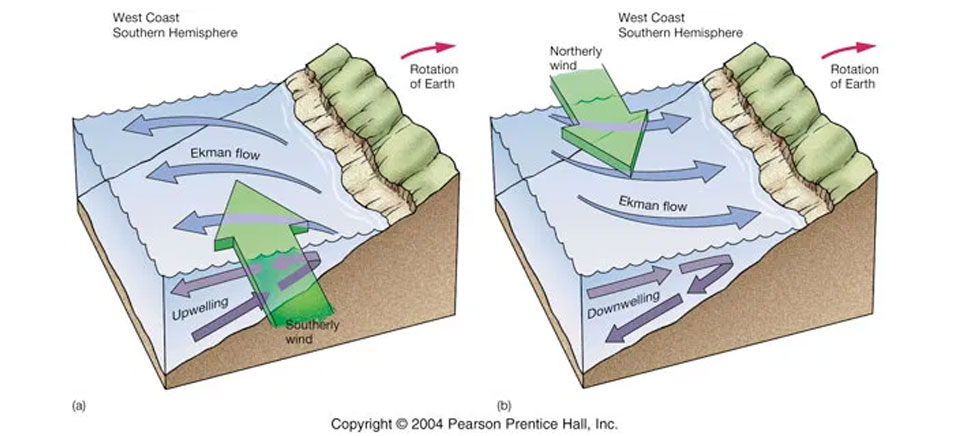Upwelling
When winds drive the ocean surface water away, colder waters from the ocean’s deep is drawn up to replace the water that was driven away. This process is known as upwelling.
Upwelling usually takes place along the coastlines and open ocean. The colder water that rises to the surface as a result of upwelling is rich in nutrients. Some of the ocean’s tiniest forms of life, called phytoplankton, are found in the nutrient-rich upwelling waters. The presence of phytoplanktons attracts zooplanktons which feeds on them. Zooplanktons, in turn, become food source for a large number of fish. The process is upwelling occurs in less than 1% of the world’s oceans. Nevertheless, it accounts for more than 20% of the fish-catch of the world.
Coriolis Force and Coastal Upwelling
Coasts form some of the most significant upwelling areas in the world. However, upwelling occurs in the coastal areas only when the wind blows parallel to the coast. This is because of the Coriolis Force.

The Coriolis Force causes objects travelling in straight direction to deflect due to the Earth’s rotation from west to east. In the northern hemisphere, the water deflects towards the right side of the wind. Similarly, the deflection of water is towards the left side of the wind in the southern hemisphere. In absence of the Coriolis Force, the water near the coastal region would not be pushed away. As a result, no upwelling will take place.
Downwelling
Downwelling is exactly the opposite of upwelling. It occurs when wind causes surface water to build up along a coastline. As the surface water comes together or converge, it starts sinking deep beneath – towards the bottom of the ocean. Downwelling occurring regions have lower nutrients due to which biological productivity also remains low in these regions. This is the reason why these areas are not considered viable for fishing activity.
Use the citation below to add this article to your bibliography
"Upwelling and Downwelling: Definition and the Role of Wind Current." Dashamlav.com. Web. 13 June 2025. <https://dashamlav.com/upwelling-downwelling-definition/>
Dashamlav.com, "Upwelling and Downwelling: Definition and the Role of Wind Current." Accessed 13 June 2025. https://dashamlav.com/upwelling-downwelling-definition/
"Upwelling and Downwelling: Definition and the Role of Wind Current." (n.d.). Dashamlav.com. Retrieved 13 June 2025 from https://dashamlav.com/upwelling-downwelling-definition/
